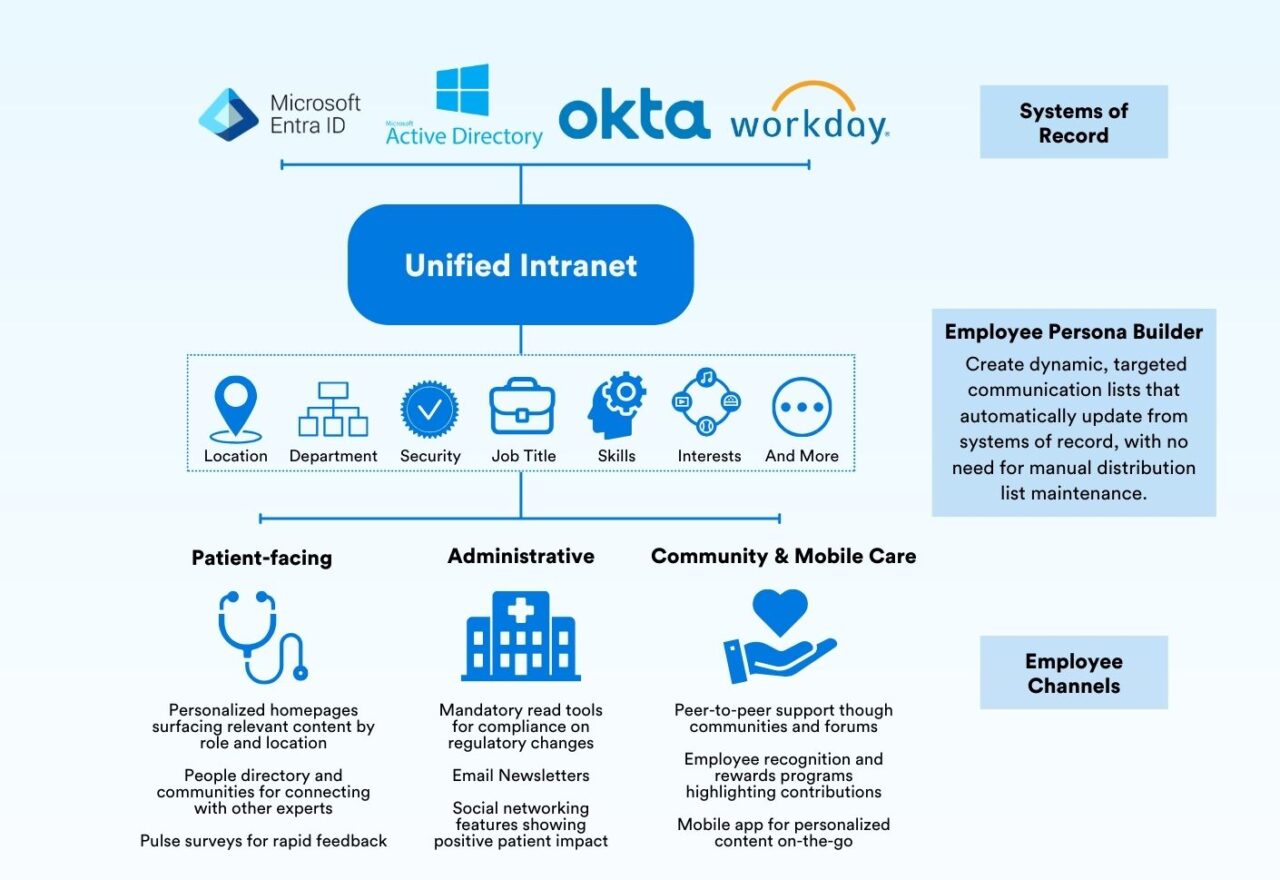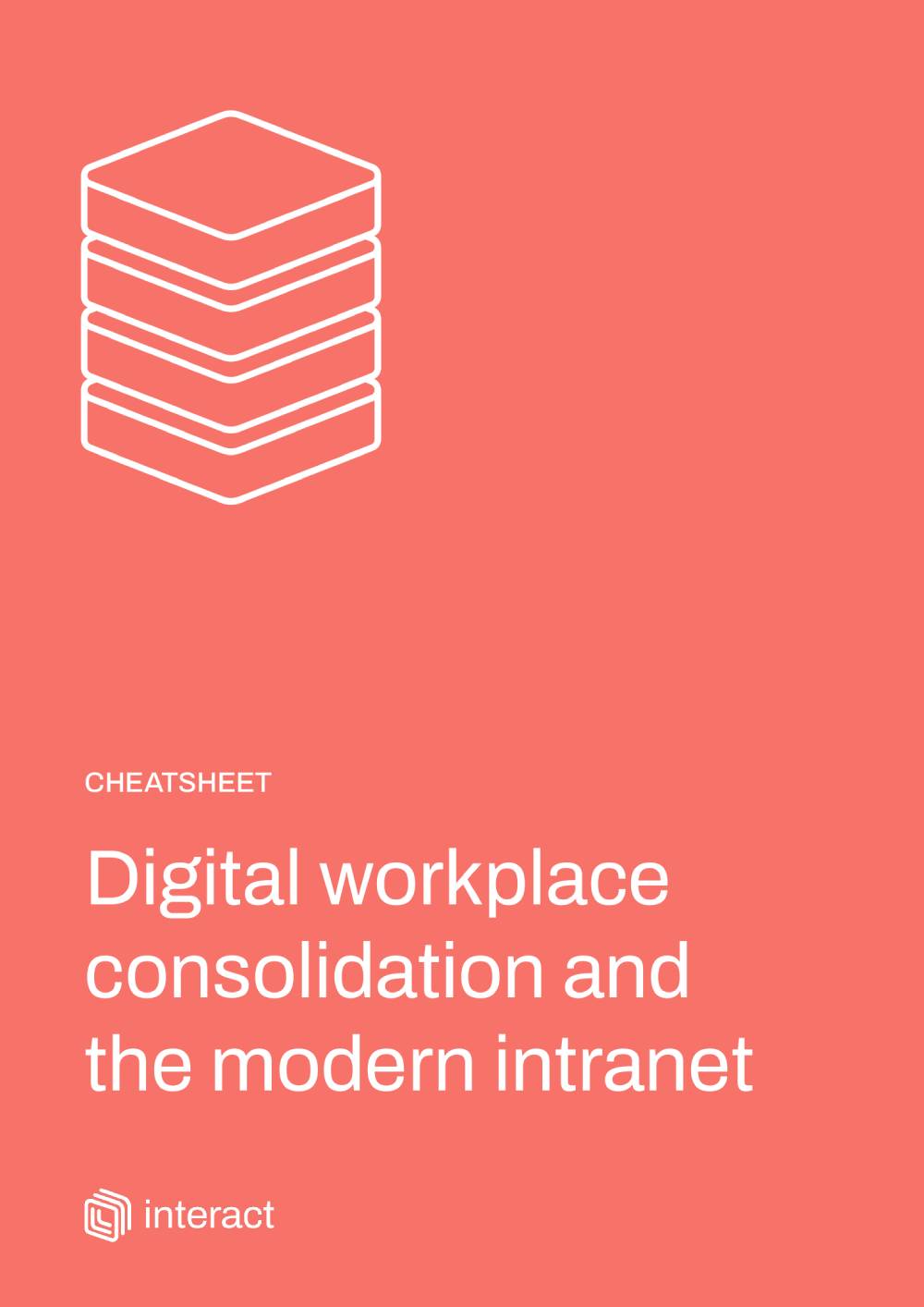Healthcare technology consolidation is becoming increasingly vital. Over the past several years, the industry has seen a growing volume of single-purpose apps and platforms that can hinder comms, employee experience, and organizational goals. This article explores why tech consolidation is especially important for healthcare, and how a strategic employee experience platform can facilitate it.
Ask any employee in any industry if their workplace requires them to use too many different types of software, apps, or platforms. Chances are you’ll get a resounding yes in response.
Employees everywhere are indeed experiencing technology fatigue, but the healthcare industry is one of the most impacted. Between time-strapped employees who require efficiently delivered, specialized information, a dispersed workforce with varying needs, and shift-based, bedside, or lab work that makes staff hard to reach, healthcare organizations must be wary of creating overloaded digital workplaces that make circumstances even more challenging.
Streamlining technology solutions can help organizations meet the unique challenges of healthcare’s workforce, improving efficiency, employee experiences, and patient care. This article explains why, and explores how consolidation can be accomplished using a comprehensive employee experience platform.
Your roadmap to digital workplace consolidation
Technology overload in healthcare today
Like many other industries, healthcare organizations today are plagued by technology overwhelm.
There’s a lot that needs to happen in the digital workplace. Needs and solutions can accumulate over time, so reliance on a variety of solutions rather than a singular one is the norm. If the growing number of applications is left unchecked for several years, a company may find itself with an excessive number of platforms that all serve different purposes – from communication to employee recognition to administrative tasks.
Common solutions in the healthcare industry include:
- Employee communication apps to serve an on-the-go-workforce
- Third-party digital signage for staff updates
- Workflow apps for administrative tasks such as staff scheduling
- Knowledge management platforms to host crucial information related to policies, procedures, and more
- Data analytics software to track organization-wide statistics and performance
These solutions are just the tip of the iceberg. Research shows that large enterprises can have over 200 apps in use by employees, proof of just how out of hand technology solutions can become if left unchecked.
Implications for employees
Staff are among the most eager for healthcare technology consolidation. A recent survey found that 91% of employees are frustrated by fragmented workplace technologies, and healthcare workers are no exception – in fact, they’re especially vulnerable to technology overload.
Healthcare staff don’t simply dislike switching between different apps, platforms, and websites – they don’t have the time to do so either. Many are already dividing their workdays among administrative tasks such as charting, research, billing, or report-writing and deskless activities such as patient care or lab work. When they have so many apps at their fingertips, it’s easy to forget which one to use for which purpose. As a result, the solutions lose their utility.

With all the unpredictable factors involved in their jobs, healthcare employees may also be especially vulnerable to change fatigue, and resist adopting new technology. This is especially true for long-term staff, who have seen technology accumulate over the years and are growing sick of learning new software for every task they need to complete.
In this scenario, it’s easy to see how communications can get lost. If employees aren’t using all the solutions they should be, they likely aren’t receiving the information and support they need to do their jobs effectively.
Your roadmap to digital workplace consolidation
Implications for comms, HR, and IT teams
In addition to its impact on healthcare employees, excess technology solutions also present issues for the comms, HR, and IT teams who support them.
The unique characteristics of this audience – shift work, time shortages, and multiple locations, to name a few – make it difficult for HR and communicators to reach them under ideal circumstances. But with too many channels it’s even more difficult to dispatch and track messaging.
Solution overload also means the lack of a single source for employees to retrieve important information and complete tasks. Everything from submitting an IT ticket or leave request to accessing the latest HIPAA requirements becomes more difficult for employees when they’re not clear on where to find what they need. This results in an overabundance of unnecessary inquiries to HR and IT support teams.
The organization will also suffer from an IT perspective. In healthcare, patient data security is paramount. All vendors must be vetted intensely (and re-vetted over time) to ensure compliance. Plus, the more solutions an organization has, the more risks of a patient data breach there are. Healthcare technology consolidation is a crucial strategy to mitigate these risks.
A move toward change
In an industry where organizations must cut costs, optimize efficiency, improve staff experiences, and make thoughtful decisions about emerging tech solutions, healthcare technology consolidation is top-of-mind.
IT leaders and executives have been taking notice of technology bloat for some time, and now they’re taking action. One survey by Forrester found that over 90% of organizations are actively seeking a unified IT platform, and 62% have already begun to consolidate to a handful of core platforms.
It’s clear that healthcare organizations that don’t prioritize streamlining technology will be at a disadvantage. But getting started can seem like an enormous undertaking. What’s the best way to consolidate healthcare technology without sacrificing staff experience, financial interests, or patient care?

An integrated communication and employee experience platform can help healthcare organizations consolidate technology with ease. We’ll explore how later in the article. First, we’ll go over the unique considerations for the healthcare industry when it comes to tech consolidation.
Healthcare technology consolidation considerations
For hospitals, medical centers, and other organizations delivering health services, communication and employee experience challenges arise from the perpetually moving nature of many frontline staff.
While administrative and managerial employees have email accounts or can visit the intranet, clinicians, nurses, maintenance, and security staff are all examples of those who need communication and information but do not have instant access.
The organization still wants to communicate with these people and enable them to feel valued, however. This requires a connected, streamlined digital workplace to empower a workforce bearing a heavy burden.
Your roadmap to digital workplace consolidation
Factors to keep in mind when embarking on healthcare tech consolidation
When consolidating and optimizing a digital workplace for healthcare, some factors to consider include:
A specialized workforce with varying schedules, locations, and access
Healthcare relies on a vast array of senior, long-tenured professionals – from doctors and nurses to technicians and administrative staff. Each role has distinct communication needs and may work in different clinical settings such as hospitals, clinics, or labs. This presents challenges when it comes to reaching everyone effectively. This group of employees are more likely to be highly experienced with the organization and may need information rather than the onboarding or engagement building that’s necessary for high-turnover industries.
Similarly, many healthcare workers operate on rotating shifts or have limited access to technology during patient interactions. This makes it difficult to coordinate real-time communication and deliver timely updates.
Beyond hospitals, healthcare professionals often work in geographically dispersed locations, such as home care or rural clinics, adding another layer to ensuring consistent communication reach.
So much information, so little time
Balancing patient care with administrative tasks and absorbing new information can be overwhelming, leading to information overload and difficulty prioritizing communication needs. In these situations, time-pressured staff need simple, fast ways to feed back information or process the new updates most relevant to them.
A need for community and support
In a high-pressure environment, frontline healthcare workers face stress and the potential for trauma. This can impact communication with colleagues and patients, leading to burnout and decreased employee engagement. Access to mental health resources and support structures must be prioritized. Peer-to-peer communications, recognition tools, and feedback processes should be similarly valued.
All these challenges can be resolved through healthcare technology consolidation using a unified employee-focused intranet solution with a deep feature set.
Your roadmap to digital workplace consolidation
Healthcare tech consolidation using an employee experience platform
If healthcare organizations today want to thrive, they must reduce the number of solutions they use to reach, inform, and engage their workforce. To do so, they must first find a way to replace these single-use solutions with a multipurpose one, without sacrificing quality.

This is now possible with a unified, full-featured employee experience intranet solution. Organizations will want to be choosy about which one they select, because effectively streamlining technology requires much more than most run-of-the-mill intranet solutions can deliver. They’ll need a platform that serves as a single source for every digital workplace need, from finding information to completing tasks to participating in the organization’s culture.
The right employee experience intranet enables healthcare organizations to:
- Ensure that vital updates reach every employee, regardless of shift schedule, type of role, or work location – this includes staff who are on the move or don’t have access to a computer while engaging in patient care
- Reduce digital overwhelm, preventing resistance to participation in the digital workplace
- Give staff a go-to location for the key updates, policies, and procedures that are crucial to safety, compliance, and patient outcomes
- Improve the efficacy of IT, HR, and comms teams by preventing duplicated efforts that come from managing several different tools at the same time
- Utilize employee recognition, feedback management, peer communication, mental health resources, and other features to build a company culture that supports employees who may experience stress, trauma, and burnout as part of their roles
With all these benefits and more, a carefully selected, unified solution is just what organizations need to optimize the technology experience for staff.
Healthcare technology consolidation in practice
Kent Community Health NHS Foundation’s employees provide over 70 different services to more than two million patients. They need instant access to information and resources that support patient care.
Challenges
Kent Community Health’s legacy intranet had become a dumping ground for information and documents. Underpinned by a poor search experience and a lack of defined structure, it hosted over 5,000 documents and several hundred pages. It was causing staff to waste considerable time when they failed to find the information they needed to do their jobs helping patients.
The Trust also faced difficulties engaging frontline staff, many of whom did not have easy access to a computer when on the job.

Solutions
Kent Community Health defined clear objectives and then worked with Interact to develop their new employee-centric intranet. Kent’s new platform:
- Enables colleagues to find the right contacts to help them solve problems, ask questions, get help, and make appropriate referrals
- Makes finding useful, usable policies, procedures, and forms easy
- Allows staff to find out what training they need (or might like) to do, outlines how to book and complete it, and provides well-written information relevant to their roles
- Keeps staff up to date with Trust-wide news and updates, as well as tailored bulletins, updates, and targeted, role-based messages
Consolidating healthcare technology with an intranet
As we’ve been over above, healthcare organizations today are suffering from the negative ramifications of too many employee-facing solutions. There’s a major need for healthcare technology consolidation throughout the industry. Replacing the excessive number of existing solutions with a single platform that tackles the majority of communication, information hosting, and digital employee experience functions helps organizations connect staff across departments and locations, ensure the right messaging gets to the right people at the right times, and improve operational efficiency. This results in better organizational outcomes and improved patient care.
Interested in how tech consolidation can benefit businesses in other sectors? Check out our other articles on digital workplace consolidation for finance, construction, retail, and franchise organizations.


